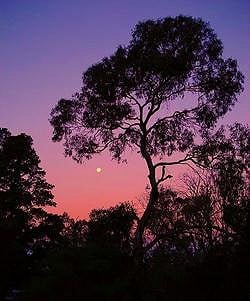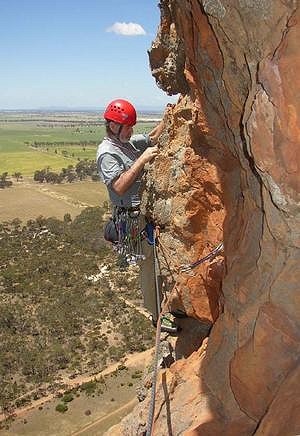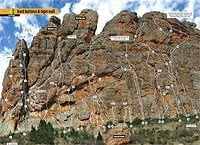

The Pharos is a huge fairly flat-topped pinnacle about 80m high and about 40m square at its base. Its front face is seamed with grooves and gullies, some of which go at remarkably easy grades (about severe), while this is also home to one of the great Aussie hard routes, Punks in the Gym. The back wall, which is nice and shady for hot weather climbing, sports a lower 25m or so which leans well the hard side of vertical, and naturally is home to some modern desperates; it's not the sort of place where you'd expect to find a route suitable for a couple of modest climbers looking forward to getting their old age pensions in a year or two. But you'd be wrong, for here also lies the most memorable route so far of my long and undistinguished climbing career. Lamplighter is a Grade 14, which in this case means solid VS 4c.
The first pitch is quite innocuous, starting up a series of little right-leaning overhung ramps starting from the left hand side of the impending wall. Just when you're wondering where it goes next, you find a bottomless chimney above you leading back though the roof and on to a kind of blob of rock with a commodious ledge well furnished with belays. As you start the second pitch, I realise I should have warned you to scramble up the rocks near the start to suss out the route by matching up the photo in the guide book with the crag. Oh well, too late now. The theme of the first pitch continues, but the ramps are now steeper, narrower, and the holds smaller, and the exposure...... Getting off the belay ledge is tricky, and is protected by a peg, rather unnecessary in this age of cams, but clip it anyway. The ramps are now unrecognisable as such: they're steep walls. The third ramp is really a kind of groove; you're climbing on strange chicken-heads now, and this ramp seems to be overhanging, really stretching the definition of the word. You're on a vertical wall with a steeper one that you can't see below, climbing diagonally away from the stance. Just check you've got those prussiks. A lay-off move lands you on a little pulpit where the exposure makes you quiver. Still, room to take stock and a breather.
Above you lurks a repellent wide crack-cum-narrow chimney, which if you'd taken my advice and looked at the picture in the guidebook before you started you'd know wasn't the way. Well that's a relief, until you realise nothing else looks remotely feasible. The exposure is now mind-numbing; have you really got to teeter off round the blunt arête to the right to something you can't see, above that aching void? You sure have! It's the psychological crux, and when you've done it you find yourself on a small sloping ledge just-and-so in balance at the bottom of a very in-your-face V-groove. Looking behind and down doesn't seem a good idea. A little prayer “let there be a good runner” is fortunately answered in the affirmative, and then, while you're still gibbering from the head crux, here's the technical crux, up that steep groove with one high, polished, inadequate toe-hold and handholds no better than they ought to be. Then a bit of easy bridging leads to the comfort of a large, enclosed stance. You had begun to wonder whether there would be enough rope, such a big pitch does it seem. In fact there are 20 metres of slack to take in.

ABOUT ARAPILES FROM CHOCKSTONE.ORG: www.chockstone.org/Arapiles

Arapiles is home to over 2000 quality routes, condensed into one, and let's be honest, fairly small mountain. There are climbs within a stones throw of the infamous Pines campground, and you don't have to walk far at all to access hundreds of worthwhile routes. Basically if you can't find a line you like at Araps, then you're in the wrong sport.
The Pharos
This outcrop has it all. If I could pick one crag to transplant into my backyard, this would be my choice. It's got a climb for every mood and every skill level. From the beginners ramble "Spiral Staircase" 95m grade 8, right up to the all time classic Araps test piece "Punks In The Gym" 35m grade 31, which, for a short while was considered the hardest route in the world and still attracts overseas visitors today. A block to the side of the Pharos called Death Row Pinnacle offers the challenging but very rewarding "Death Row" 45m grade 18. The Pharos front wall, sheltered from the rain, gives you such classics as "Oceaniod" 75m grade 17, while the back wall houses the well trodden route "Lamplighter" 78m grade 14, which usually has a queue three parties deep. There's also several three star grade 21 and above climbs here. Gotta love the Pharos. Even the free hanging 50m abseil descent is an adventure!
How To Get To Arapiles
The park is 320 km north-west of Melbourne and 440 km from Adelaide (Melway 520 A9). It is directly accessible from the Wimmera Highway, 30 km west of Horsham. Mount Arapiles and Mitre Rock are 8 km west of the small town of Natimuk and Tooan another 12 km to the south-west. Access into the Tooan block is via minor roads.

The new edition of the Arapiles Selected Climbs guide is due out in summer 2008. It will be in full colour, in a larger format and with even more routes and more topos. Click here if you want to download a PDF file of Bard Buttress and Tiger Wall topo for a taste of what is to come.



Comments